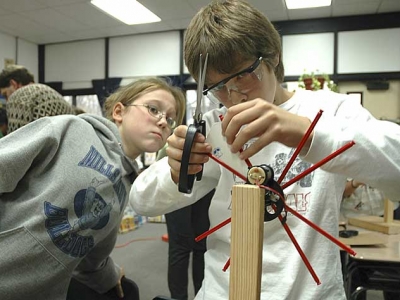School crisis options eyed
- Published: January 29, 2015
A desire to put resources into preventive mental health initiatives emerged as a theme last Thursday at a community meeting on school safety measures attended by about 35 school district parents, teachers and staff.
In his 35 years as a school teacher, principal and counselor, Mills Lawn Counselor John Gudgel said there have been three incidents involving students bringing guns to school. One of those incidents involved a student bringing a hunting rifle by mistake, and the others involved troubled young people, Gudgel said.
“These were mental health issues,” he said.
Yellow Springs School Board President Aïda Merhemic recalled a recent Ohio School Board Association meeting attended by school leaders from Chardon, Ohio, where a school shooting took place in 2012. The Chardon group encouraged others to find ways to prevent shootings before they occur, Merhemic said.
“They said get all the skills you can get regarding safety, but put your money into mental health training,” Merhemic said of the event. “Have people caring for your kids to prevent these tragedies.”
The discussion on school safety was called by District Superintendent Mario Basora as the district ramps up to produce a new crisis plan. The plan, which will be finalized by a school safety committee comprised of staff and community members, needs to be submitted to the Ohio Attorney General’s office by April, he said.
While the district currently has a crisis plan (the details of which Basora said he can’t reveal), there were two potential changes for which he sought community input, Basora said at the meeting. First, district leaders are considering locking the doors to school buildings, and secondly, the district is considering the use of the A.L.I.C.E. (Alert, Lockdown, Inform, Counter and Evacuate) strategy in a crisis situation. District teachers and staff were given A.L.I.C.E. training in October.
Several at Thursday’s meeting expressed concerns over locking school doors.
“It’s a bad idea,” parent Deb Zendlovitz said, since she believes past school shootings have most often been initiated by people already in the building. Zendlovitz also expressed a concern that having locked doors could inhibit police response.
But there is a need to “pause” those coming into the school so that school staff can identify them, according to Mills Lawn staff member Roberta Semler, who works at that school’s front desk. Currently, those entering the school are asked to first report to the front desk, but some don’t do so, Semler said.
About 85 percent of U.S. schools do currently lock their doors and use doorbells to let in visitors, Basora said. However, some schools use a vestibule entry system, in which a clear glass vestibule funnels visitors into the school office upon entering the school. At the end of the meeting, Basora stated that he heard consensus in favor of the vestibule system for Mills Lawn, while a locked door with a buzzer might be more appropriate for the high school.
Regarding the A.L.I.C.E. training and strategy, Basora said the most significant difference between the currently used crisis plan and A.L.I.C.E. is that A.L.I.C.E. encourages teachers and students to evacuate the building if possible.
“Our current practice is to sit still and wait. I think that’s a huge mistake,” Basora said.
Several who took part in the A.L.I.C.E. training said it was helpful in giving teachers options, and a new perspective of how to respond to a crisis.
“I felt empowered,” said aide Donna Haller.
However, the A.L.I.C.E. strategy has sparked controversy, Basora said, especially the “counter” aspect of the strategy’s acronym. Considered a last resort during a crisis situation, the “counter” component involves teachers and possibly students distracting a shooter by using movement and noise.
Meeting participants appeared in consensus that younger students would not be involved in “counter” activities, although high school students could be. Most important, Yellow Springs can shape a response using aspects of A.L.I.C.E. that are appropriate to this community, according to YSHS teacher Vickie Hitchcock. Several participants also expressed concern over the language used around crisis drills, especially around young children, so that the drills themselves don’t inspire fear.
“We’re as soft and light as we can be,” while still being honest, Mills Lawn Principal Matt Housh said regarding talking to MLS students.
Parents and teachers also stressed the need for structural improvements to help teachers and students to exit current school buildings, as part of the evacuation component of A.L.I.C.E.
Some parents questioned the need for A.L.I.C.E. and crisis drills in general, citing statistics that show shooter events to be extremely rare.
“We’re more likely to get struck by lightning,” said Kate Hamilton, stating that she worries that language around crisis drills instills fear in children. “I’m not going to be afraid all the time.”
Several staff members acknowleged that school staff are far more likely to interact with angry parents embroiled in custody battles over children, a situation that happens two or three times a year, according to Basora. And Susan Griffith of the district office encouraged leaders to make sure that front-office staff have the means to lock doors in the face of such situations.
“This is the day-to-day thing that we deal with,” she said.
At the end of the meeting, Basora said the next step is to take the feedback from the Jan. 13 meeting and incorporate it into a revised crisis plan, to be developed by the school safety committee comprised of teachers, staff, parents and community members. The meeting gave direction, according to Basora, although he said the specific plan will not be made public due to safety concerns, but will be distributed to local police and school personnel.
The Yellow Springs News encourages respectful discussion of this article.
You must login to post a comment.
Don't have a login? Register for a free YSNews.com account.
Parkinsons.jpg)














No comments yet for this article.